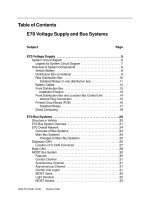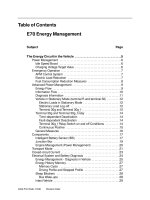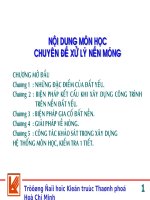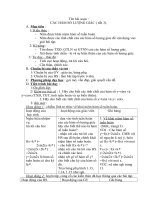C836 03
Bạn đang xem bản rút gọn của tài liệu. Xem và tải ngay bản đầy đủ của tài liệu tại đây (26.73 KB, 3 trang )
Designation: C 836 – 03
Standard Specification for
High Solids Content, Cold Liquid-Applied Elastomeric
Waterproofing Membrane for Use with Separate Wearing
Course1
This standard is issued under the fixed designation C 836; the number immediately following the designation indicates the year of
original adoption or, in the case of revision, the year of last revision. A number in parentheses indicates the year of last reapproval. A
superscript epsilon (e) indicates an editorial change since the last revision or reapproval.
This standard has been approved for use by agencies of the Department of Defense.
Applied Waterproofing Membrane2
C 1375 Guide for Substrates Used in Building Seals and
Sealants2
C 1471 Guide for the Use of High Solids Content Cold
Liquid-Applied Elastomeric Waterproofing Membrane on
Vertical Surfaces2
C 1522 Test Method for Extensibility After Heat Aging of
Cold Liquid-Applied Waterproofing Membranes2
D 2240 Test Method for Rubber Property—Durometer
Hardness3
2.2 Other Standards:
CAM/CGSB-37.58 Membrane, Elastomeric, Cold-Applied
Liquid, for Non-Exposed Use in Roofing and Waterproofing4
1. Scope
1.1 This specification describes the required properties and
test methods for a cold liquid-applied elastomeric-type membrane, one or two component, for waterproofing building decks
and walls subject to hydrostatic pressure in building areas to be
occupied by personnel, vehicles, or equipment. This specification applies only to a membrane system above which a separate
wearing or traffic course will be applied.
NOTE 1—See Guide C 898 and Guide C 1471 for proper application of
membrane.
1.2 The values stated in SI units are to be regarded as the
standard. The values given in parentheses are for information
only.
1.3 This standard does not purport to address all of the
safety concerns, if any, associated with its use. It is the
responsibility of the user of this standard to establish appropriate safety and health practices and determine the applicability of regulatory limitations prior to use.
1.4 There are no ISO standards similar or equivalent to this
ASTM standard.
3. Terminology
3.1 Definitions—Refer to Terminology C 717 for definitions
of the terms used in this standard.
4. Comparison to Other Standards
4.1 The committee with jurisdiction over this standard is
aware of one comparable standard published by another
organization. CAM/CGSB-37.58 has differences including a
test method for Dimensional Stability and Water Absorption.
2. Referenced Documents
2.1 ASTM Standards:
C 717 Terminology of Building Seals and Sealants2
C 794 Test Method for Adhesion-in-Peel of Elastomeric
Joint Sealants2
C 898 Guide for Use of High Solids Content, Cold LiquidApplied Elastomeric Waterproofing Membrane with Separate Wearing Course2
C 1250 Test Method for Nonvolatile Content of Cold
Liquid-Applied Elastomeric Waterproofing Membranes2
C 1305 Test Method for Crack Bridging Ability of Liquid-
5. Physical Requirements
5.1 Material—Membrane materials shall cure, after application by spreading or spraying, to form an elastomeric film
capable of maintaining a seal against liquid water.
5.2 The physical, mechanical, and performance properties
of the membrane shall conform to the requirements described
in Table 1.
6. Test Methods
6.1 Standard Conditions—Standard conditions for all tests
shall be 23 6 2°C (73.4 6 3.6°F) and 506 5 % relative
humidity.
1
This specification is under the jurisdiction of ASTM Committee C24 on
Building Seals and Sealants and is the direct responsibility of Subcommittee C24.80
on Building Deck Waterproofing Systems.
Current edition approved Feb. 10, 2003. Published April 2003. Originally
approved in 1976 as 836 – 76. Last previous edition approved in 2000 as
C 836 – 00.
2
Annual Book of ASTM Standards, Vol 04.07.
3
4
Annual Book of ASTM Standards, Vol 09.01.
Canadian General Standards Board, Ottawa, Canada, K1A 1G6.
Copyright © ASTM International, 100 Barr Harbor Drive, PO Box C700, West Conshohocken, PA 19428-2959, United States.
1
C 836 – 03
TABLE 1 High Solids Content, Cold Liquid-Applied Elastomeric Waterproofing Membrane Physical Requirements
Property
Requirement
Hardness, Type 00, min
50
Weight loss, max, %
Nonvolatile, min, %
Low temperature crack bridging
Film thickness (vertical surface),
min, mm (mils)
Adhesion-in-Peel after water
immersion, N/m (lbf/in.)
Optional test for adhesion-in-peel
20
80
no cracking
1.5 6 0.1 (60 6 5)
Extensibility after heat aging, min,
mm (in.)
Stability, min, months
175 (1)
Test Method
D 2240 as modified in section 6.5 of
this specification
C 1250
C 1305
See section 6.8 of this specificationA
C 794 as modified in section 6.9 of
this specification
See section 6.10 of this specification
No separation at
interface
6.4 (1⁄4), no cracking
C 1522
6
See section 6.12 of this specifcation.
A
Numbers refer to portions of the Test Methods section, Section 6, of this specification.
applications, and the complete film thickness shall be accomplished in 48 h in accordance with the manufacturer’s instructions.
6.8.3 Immediately after applying the film, place the coated
slab on its end, in a vertical position, and let remain in this
position for 24 h at standard conditions.
6.8.4 Using a vernier caliper, measure the thickness of the
total assembly at five points within 25 mm (1 in.) of the top end
of the slab. Cover the film at each point of measurement with
a 25-mm (1 in.) square piece of aluminum, 0.5 mm (0.002 in.)
thick, to prevent point indentation on the film.
6.8.5 Cut a 25-mm (1-in.) wide band of film from across the
top of the mortar strip. Measure the thickness of the test mortar
in approximately the same five locations that measurements
were made in 6.8.4. Determine the average.
6.8.6 Determine the film thickness by subtracting the average test mortar thickness from the average total assembly
thickness (test mortar and film).
6.9 Adhesion-in-Peel After Water Immersion:
6.9.1 Perform the test as specified in Test Method C 794
with the following qualifications:
6.9.1.1 Mortar shall be the test substrate. Other substrates
may be tested when specified.
6.9.1.2 The cure conditions shall be 14 days at standard
conditions, followed by 7 days at 70 6 2°C (158 6 3.6°F).
6.9.1.3 After the specimen has cured for about 7 days, coat
the cloth with a layer of the compound about 2.5 mm (0.1 in.)
thick to help minimize cloth failure.
6.10 Optional Test for Adhesion in Peel— An optional
method for running the adhesion test after the assemblies have
been completely cured is to attach a 0.45-kg (1-lb) weight to
the end of the strip of cloth, and let hang for a period of 2 min.
If no separation occurs at the interface during this period, the
film has met the minimum adhesion requirements.
6.11 Extensibility After Heat Aging:
6.11.1 Test in compliance with the requirements of Test
Method C 1522.
6.12 Stability—When stored at a temperature not exceeding
27°C (80°F) in a dry environment, or kept protected from
moisture, or both, the membrane material shall be capable of
meeting the requirements of this specification for at least 6
months from the time of delivery.
6.2 Conditioning/Mixing:
6.2.1 Store all membrane materials to be tested in an
unopened container at standard conditions for at least 24 h
before any test specimens are prepared.
6.2.2 Follow the manufacturer’s instructions for mixing and
preparing membrane materials for testing. Thoroughly mix
one-component samples before using. Mix two-component
compounds in the ratio recommended by the manufacturer.
6.3 Test Surfaces—In addition to the mortar test surfaces
specified, use other test surfaces when required by the specifier.
6.4 Primer—When required by the manufacturer, use a
primer as directed by the manufacturer on all substrate materials in test assemblies.
6.5 Hardness:
6.5.1 Following the manufacturer’s instructions, apply a
film of membrane, 1.5 6 0.1 mm (60 6 5 mils) thick, on a 100
by 150-mm (4 by 6-in.) piece of polyethylene film-coated
paper and allow the membrane to cure for 14 days at standard
conditions. If more than one application is required, the total
time for film application shall not exceed 48 h.
6.5.2 After curing, strip the film from the coated paper, cut
into pieces, and lay the pieces one upon another to provide a
test specimen meeting the requirements of Test Method D
2240.
6.5.3 Using a Type 00 hardness gage, obtain an instantaneous reading of the film hardness as specified in Test Method
D 2240.
6.6 Weight Loss:
6.6.1 Test in compliance with the requirements of Test
Method C 1250.
6.7 Low-Temperature Crack Bridging:
6.7.1 Test in compliance with the requirements of Test
Method C 1305.
6.8 Film Thickness on Vertical Surface:
6.8.1 Prepare mortar test blocks 152 by 76 by 25–mm (6 by
3 by 1–in.) as described in Guide C 1375.
6.8.2 Prepare the test assembly by covering one cut face of
a mortar slab with a film of membrane material 1.5 6 0.1 mm
(60 6 5 mils) in thickness, mixed and applied in accordance
with the manufacturer’s directions. Install the film in one
application unless manufacturer’s application instructions require application in several coats. If applied in several coats,
the test substrate shall be set in a vertical position between
2
C 836 – 03
7. Precision and Bias
7.1 Precision—The precision of the procedure in 6.8 for
measuring film thickness on a vertical surface is being determined. No information is presented about either the precision
or bias of the optional test for adhesion in peel, since the result
is non-quantitative.
8. Keywords
8.1 crack bridging; membrane; waterproofing
ASTM International takes no position respecting the validity of any patent rights asserted in connection with any item mentioned
in this standard. Users of this standard are expressly advised that determination of the validity of any such patent rights, and the risk
of infringement of such rights, are entirely their own responsibility.
This standard is subject to revision at any time by the responsible technical committee and must be reviewed every five years and
if not revised, either reapproved or withdrawn. Your comments are invited either for revision of this standard or for additional standards
and should be addressed to ASTM International Headquarters. Your comments will receive careful consideration at a meeting of the
responsible technical committee, which you may attend. If you feel that your comments have not received a fair hearing you should
make your views known to the ASTM Committee on Standards, at the address shown below.
This standard is copyrighted by ASTM International, 100 Barr Harbor Drive, PO Box C700, West Conshohocken, PA 19428-2959,
United States. Individual reprints (single or multiple copies) of this standard may be obtained by contacting ASTM at the above
address or at 610-832-9585 (phone), 610-832-9555 (fax), or (e-mail); or through the ASTM website
(www.astm.org).
3





![MAKE magazine [OH] 03](https://media.store123doc.com/images/document/13/ce/fj/medium_fjg1388298702.jpg)



